John A. Wheeler as a Cartoonist

|
| Wheeler in Moscow (1991). |
- Herbert Block was a political cartoonist who served eleven United
States presidents from Franklin D. Roosevelt to George W. Bush.
He is widely known as "Herblock."
Click here for some of his cartoons in the Library of Congress collection.Herblock got his honorary degree in "humane literature," and Wheeler's degree was in "science." After reading a newspaper article about their degrees, I complained to Jim Griffin. He said "Yes, Wheeler is also a great cartoonist." We agreed that Wheeler and Herblock should have receceived their degrees in the same category. For Wheeler's cartoons, look at his books.
- James J. Griffin (photo 2008) got his PhD degree from Princeton in 1956. He was Wheeler's student. He and Wheeler drew many cartoons while doing physics. He regrets he did not keep them all.
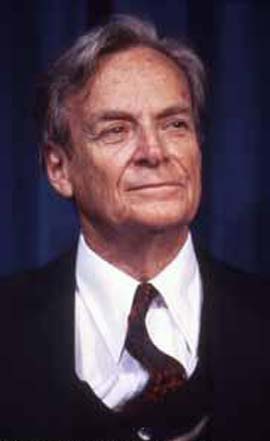
|
| Feynman (1986), from AIP Emilio Segre Visual Archives. |
- When I was a graduate student at Princeton (1958-61), John A. Wheeler
was the most talked-about professor. He was always drawing pictures.
He drew many pictures on the blackboard, but the most strange pictures
were those of worm holes.
The blackboard pictures are cartoons. Princeton's graduate students know Feynman was Wheeler's student before accepting their admissions. After seeing Wheeler's instinct to draw cartoons, graduate students of my time made up a story that Feynman picked up his habit of drawing diagrams from Wheeler. This story could even be true. If this is the case, the art of drawing Feynman diagrams can be traced to Wheeler.
This culture got transmitted very easily to Feynman because Feynman was also a great cartoonist. He used to draw pictures on the back of an envelope whenever he was thinking about physics problems. In restaurants, he was fond of drawing pictures of girls on napkins. Recognizing his own talent along this direction, Feynman in his later years hired two art instructers to become an artisit. I have a webpage entitled Feynman as an Arist
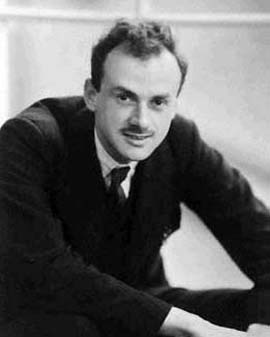
Paul A. M. Dirac,
image from the public domain. - Paul A. M. Dirac is also a great physicist. Have you seen any pictures
in his books or papers? On the other hand, he writings are like poems,
and his mathematical formulas are even more poetic. Indeed, he expressed
his ideas by writing mathematical poems. It is thus of interest to compare
these two great physicists. Click on
- Not everybody has picture-drawing talent. Do you know how to draw
pictures? I certainly do not. Can you still join the picture-loving
club of Wheeler and Feynman? How? The answer is to understand the
process in which these two great cartoonists produced their pictures.
You already know how Feynman diagrams are constructed. Organize
physics first. Then start drawing pictures.
- How do you organize physics? Here the answer is very cruel. You have
should have a good understanding of physics. Let us look at one
aspect of Wheeler's organizational talent.
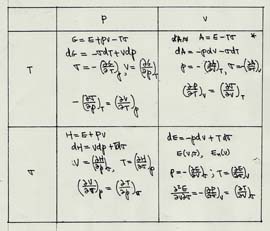
From Wheeler's Statistical Mechanics (1960). - Tables.
In addition to cartoons, Wheeler was quite fond of constructing tables.
Tables constitute a very powerful language. It is a two-dimensional
language. When I was fortunate enough to take his course on statistical
mechanics in the spring semester of 1960.
In one of his lectures, he summarized Maxwell's relations into one table like this. Have you seen this two-by-two organization of twenty equations anywhere else? It is a burden to memorize all those equations. With this table, we can firmly grasp the physical content of Maxwell's relations and venture into a more fundamental physical law. The secret of this table is the choice of the row and column variables.
- Perhaps I have a talent along this direction. If this is the case, I was
able to find it only through Wheeler's tables.

Feynman's APS talk of 1970. - Feynman's Talk in 1970. At the APS
meeting of 1970 held in Washington, DC, USA, Feynman gave a talk totally
incomprehensible to most of the audience. I was there. To me it was
the most interesting talk I had ever heard. My colleagues still tell me
I am crazy to try to make sense out of this talk. But I was able to
organize what Feynman said into this table. In this way, I was able to
find out what I had to do to make a meaningful contricbution in physics.
- Between Maasive and
Massless Particles. Did you know Wheeler was one of
the pioneers of plasma physics? He made some fundamental
contributions in fusion problems. He had to do statistical
mechanics of relativistic particles. He was wondering why and
how PV = (2/3) E for massive particles becomes
PV= (1/3) E for massless particles. He talked about this problem
and drew this table on the blackboard in his stat mech course in 1960.
Wheeler's Plasma World Massive/Slow between Massless/Fast Energy
MomentumE=p2/2m Einstein's
E=(m2 + p2)1/2E=p PV
EnergyPV = (2/3) E Wheeler's
Unsolved ProblemPV = (1/3) E I am still interested in filling in the mathematical formula which will connect 2/3 to 1/3. But the problem is how to handle the averaging processes and resulting integrations.
- Perhaps we can solve somewhat easier problems without momentum/energy
spread. If you read some of my papers, you must have seen the
following table which I constructed with my co-authors. I love
this table. You can now see how I was influenced by Wheeler.
Lorentz-covariant World Massive/Slow between Massless/Fast Energy
MomentumE=p2/2m Einstein's
E=(m2 + p2)1/2E=p Spin, Gauge,
HelicityS3
S1 S2Wigner's
Little GroupS3
Gauge Trans.Gell-Mann,
FeynmanQuark Model Lorentz-covariant
OscillatorsPartons Click here for further details of this table.
- Computer Screens as
Tables. My website contains many webpages. You also have noticed
every page is a matrix of information with row and column icons. The
problem is what titles to put into those rows and columns.
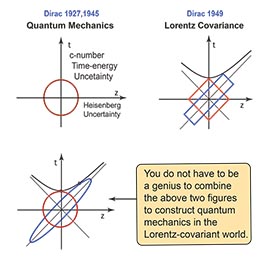
Dirac's form of Lorentz-
covariant quantum mechanics. - Feynman's Talk in 1970. At the APS
meeting of 1970 held in Washington, DC, USA, Feynman gave a talk totally
incomprehensible to most of the audience. I was there. To me it was
the most interesting talk I had ever heard. My colleagues still tell me
I am crazy to try to make sense out of this talk. But I was able to
organize what Feynman said into this table. In this way, I was able to
find out what I had to do to make a meaningful contricbution in physics.
- Circles and Ellipses.
If you do not know how to draw pictures, you can still draw circles
and ellipses. It is fun to translate journal writings into circles
and ellipses. In this way, we can gain deeper and more transparent
understanding of physics.
- Dirac's Form of Relativistic
Quantum
Mechanics. From 1927 to 1963, Paul A. M. Dirac published four
major papers in his lifelong effort to combine quantum mechanics and
special relativity. His papers are like poems with clean and clear
mathematics. However, he never attempted to draw diagrams. Thus, it
is profitable business to translate his papers into pictures. It is
possible to do this only with circles and ellipses. In this way, we
can transform those four papers into one paper.
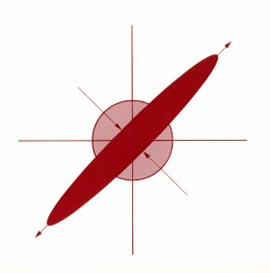
Physics of circles and ellipses. - Quantum Optics. The Wigner
function is now an indispensable tool in dealing with coherent and
squeezed states. There, quantum optics becomes the physics of
circles and ellipses.
We can therefore use one scientific language for Dirac's form of quantum mechanics and the physics of squeezed states. Click here for a detailed story.
- Dirac's Form of Relativistic
Quantum
Mechanics. From 1927 to 1963, Paul A. M. Dirac published four
major papers in his lifelong effort to combine quantum mechanics and
special relativity. His papers are like poems with clean and clear
mathematics. However, he never attempted to draw diagrams. Thus, it
is profitable business to translate his papers into pictures. It is
possible to do this only with circles and ellipses. In this way, we
can transform those four papers into one paper.
- Power of Pictures. It is easy
to find out strengths and weaknesses of other people, but it is very
difficult, if not impossible, to find out about oneself. I was not an
exception. Indeed, I had to struggle during the early years of my
professional life. I was not happy to follow bandwagons. I started
finding out myself in 1965. At that time, quantum bound states come
from poles in the complex energy plane or from "bootstrapping" processes.
Wave functions had nothing to do with physics. I was not able to accept
this view.
In 1965, the physics world was all excited about Dashen's calculation of the np mass difference. Roger Dashen, a young physicist of my age, became elevated by Princeton to the genius class. I was unhappy because of my Herod complex.
The physics world had and still has a belief that the proton and neutron have the same mass but their mass difference comes from an electromagnetic perturbation. In his PhD thesis, Dashen came up with the correct value of this mass difference using the perturbation formula derived from the S-matrix theory.
In 1965, I published a paper showing Dashen's perturbation formula is based on one non-localized wave function as shown in this figure. I did not include this paper in my paper, and people did not believe what I was saying, because Dashen was a genius and I was something else (perhaps someone from a country that could not produce cars). Some people told me they would not accept my result because I was using wave functions instead of the S-matrix. Click here for details.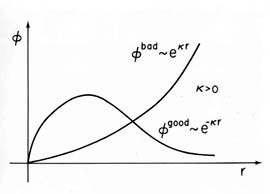
δ E = (φ good , δV φbad).
Dashen's wrong calculation of the neutron-proton mass difference.At that time, I did not have a tenure, and my position was in danger because of this paper. I was looking for a job and had to give seminars at other institutions. While answering questions, I came up with this figure of wave functions, and was able to appreciate the power of pictures. To make a long story short, this figure saved my position in the United States. This figure also has a history from my undergraduate years at Carnegie Tech. The United States has been very nice to me since I came to Pittsburgh from Korea in 1954.
This was a great revelation in my physics life. Pictures are powerful. Since then, when I write a paper, I first construct a set of figures, and the rest of the paper consists of figure captions. I got into Wheeler's track in this way. John Archibald Wheeler was much more than the black hole. First of all, he was a great teacher!
Equally serious, perhaps so, is the disappearance of beautiful mind. Let us see whether we can photograph the abstract concept of beautiful mind.
- Beautiful Mind,
from the webapge "Feynman as an Artist."
- Wheeler Photos. Wheeler had a beautiful mind.
Y. S. Kim (2016.9.30)
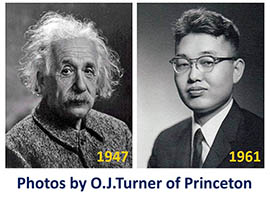
|
| Why is he with Einstein? |
- Click here for his home page.